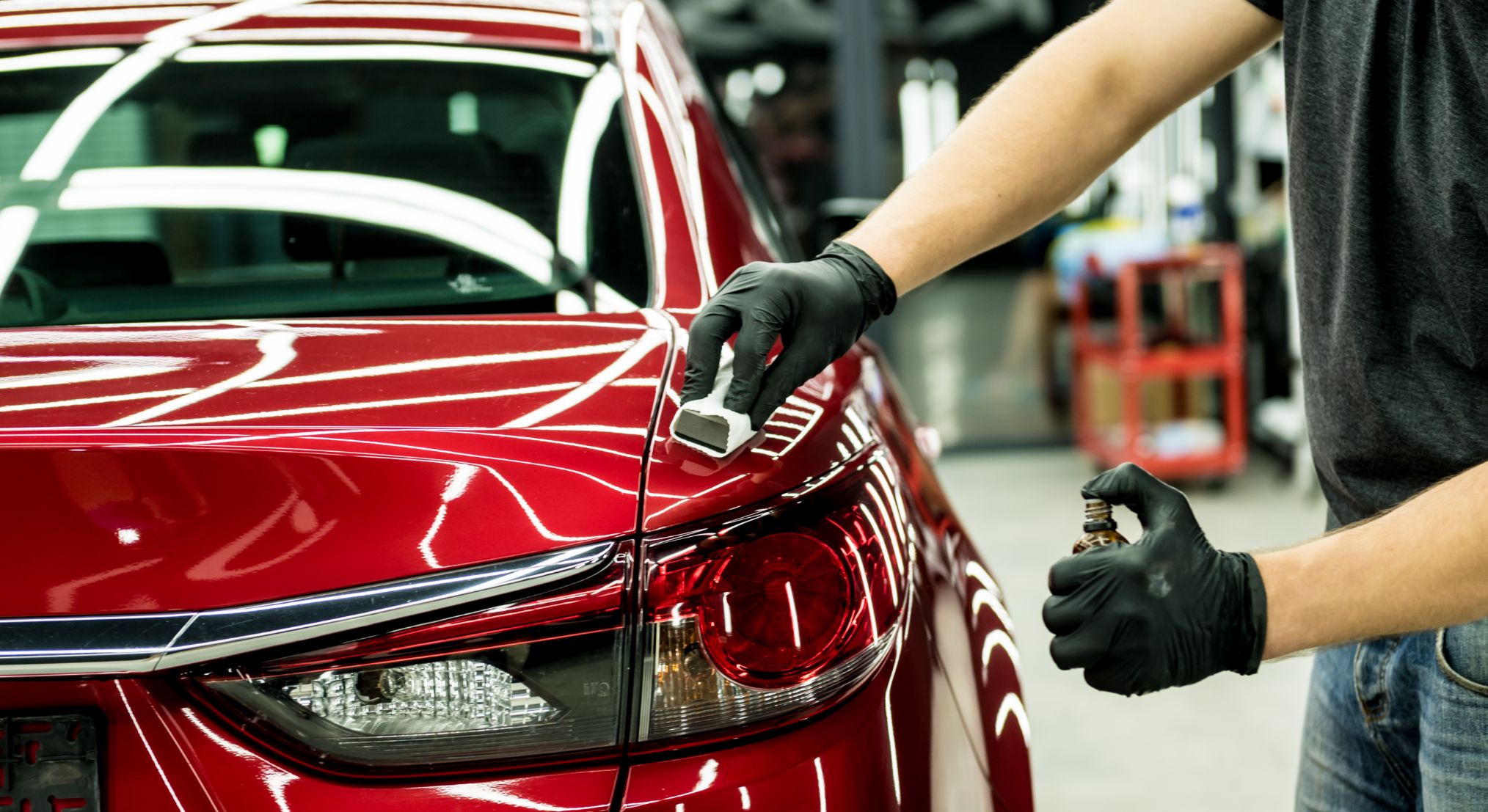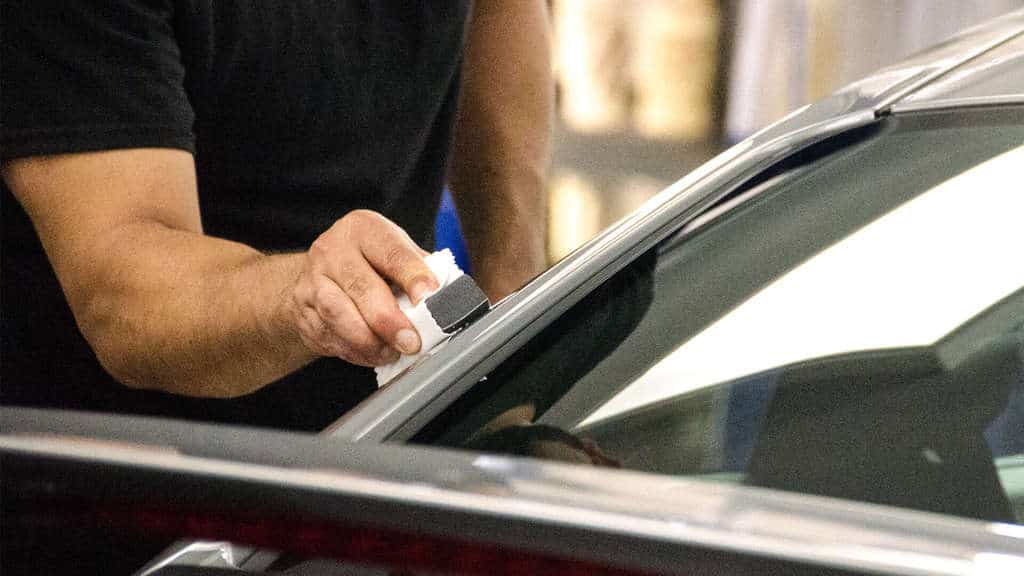Exactly How Ceramic Coating Secures Your Vehicle's Paint and Maintains It Looking New
Ceramic covering has actually arised as a sophisticated option for automotive paint protection, using an awesome barrier against the aspects. The result is a significant reduction in paint deterioration and an enduring visual allure.
What Is Ceramic Finish?

When applied properly, ceramic coverings develop a semi-permanent bond with the surface of the lorry, offering superior protection versus UV rays, chemical discolorations, and minor scratches - ceramic coating. Unlike conventional wax or sealants that might wear away within months, ceramic coatings can last for years, depending on the item and maintenance
The application process entails complete surface area prep work, consisting of cleaning, sanitizing, and brightening the paint to guarantee optimum bond. As soon as the covering is used, it hardens and remedies, leading to a hydrophobic surface area that wards off water, dust, and grime. This hydrophobic residential property not only makes the car much easier to tidy but likewise improves the general gloss and quality of the paint, adding to a showroom-quality finish. Ceramic finishing is progressively preferred by cars and truck fanatics and specialists looking for long-lasting paint protection.
Advantages of Ceramic Layer
Why should vehicle owners think about buying ceramic finishing? The advantages of ceramic layer extend far beyond simple visual appeals, offering significant protection and longevity for a car's paintwork. One of the primary advantages is its phenomenal resistance to environmental impurities. Ceramic finishings produce a hydrophobic surface, allowing dust, grime, and water to glide off quickly, minimizing the regularity of cleaning and the demand for typical waxes.
Furthermore, ceramic coatings supply a robust shield versus UV rays, which can cause paint to oxidize and discolor in time. This safety layer helps preserve the vibrancy and gloss of the automobile's color, guaranteeing it looks new for many years. Furthermore, ceramic coverings are known for their sturdiness; they can last several years with correct upkeep, making them an economical investment over time.
An additional significant advantage is the convenience of maintenance they provide. With a ceramic-coated surface area, minor scratches and swirl marks are less most likely to take place, and when they do, they are easier to buff out. Generally, the financial investment in ceramic coating not only improves the aesthetic appeal of a car yet also gives long lasting protection that can conserve automobile proprietors money and time.
Exactly How Ceramic Finish Works
Understanding exactly how ceramic coating jobs is vital for vehicle owners considering this safety option for their vehicle's paint. Ceramic finishings are made up of sophisticated nanotechnology that forms a long lasting, protective layer over the surface area of the vehicle's paint. When used, these liquid polymers bond chemically with the factory paint, producing a strong, hydrophobic layer that drives away water, dust, and various other pollutants.
The key part in ceramic coverings is silicon dioxide (SiO2), which supplies the finishing's hardness and resistance to UV rays, chemicals, and scratches. This molecular bonding produces a protective guard that is dramatically harder than standard wax or sealants, offering long-lasting defense. The hydrophobic nature of the finish indicates that water beads up and rolls off the surface, taking dust and grime with it, consequently making the automobile much easier to clean up.

Application Refine of Ceramic Finishing
The application process of ceramic coating calls for cautious preparation and focus to detail to make certain optimal outcomes. Initially, the lorry should undertake a complete cleaning to get rid of dirt, crud, and pollutants. This action typically includes a clay bar therapy to get rid of embedded particles that might compromise the finish's adhesion.
Following the cleansing, an in-depth assessment of the paint surface is important. Any type of existing blemishes, such as scrapes or swirl marks, must be dealt with via sprucing up. This ensures a reflective and smooth surface area, enhancing the final appearance of the ceramic finish.
When the paint is prepared, the ceramic layer is applied in a controlled setting to avoid dust and particles from polluting the weblink surface. Using a specialized applicator, the finishing is uniformly dispersed in areas, enabling correct bonding with the paint. It is vital to follow the manufacturer's guidelines relating to treating times and environmental conditions throughout application.
After the application, a treating duration is required for the coating to achieve its full safety residential properties. This procedure can vary in period based on the certain product used, however it is vital for accomplishing the desired durability and durability of the ceramic layer.
Upkeep Tips for Ceramic Coating
Maintaining a ceramic layer is vital for protecting its safety homes and making sure the long life of your automobile's exterior. To achieve optimum outcomes, routine upkeep is essential. Begin by cleaning your automobile utilizing a pH-neutral auto hair shampoo and a soft microfiber clean glove to stay clear of damaging the surface. Avoid automated cars and truck washes, as their severe chemicals and brushes can weaken the finish.
After cleaning, wash extensively and dry the lorry with a tidy microfiber towel to avoid click to read water places. It's suggested to do upkeep washes every 2 weeks to maintain the covering in good condition.
In addition, think about using a committed ceramic layer booster or spray sealer every few months. These items improve the hydrophobic residential properties and add an added layer of security.
Examine your car frequently for any kind of impurities such as tree sap, bird droppings, or road tar, and remove them without delay using a clay bar if essential. Park your vehicle in a garage or use a car cover to minimize direct exposure to extreme environmental elements. ceramic coating. By following these upkeep suggestions, you can guarantee that your ceramic finishing stays effective and your cars and truck keeps its display room luster
Final Thought
To conclude, ceramic finish works as a necessary safety measure for vehicle paint, providing many benefits such as enhanced toughness and resistance to environmental risks. The innovative chemical bonding process makes sure a resilient shield against impurities, UV rays, and oxidation, consequently protecting the automobile's visual appeal. Correct application and maintenance are crucial for optimizing the performance of ceramic finishes, ultimately adding to an automobile's durability and keeping a showroom-quality finish over time.
Ceramic finishing is a sophisticated safety solution designed to improve and maintain the appearance of vehicle paint. Ceramic finish is increasingly preferred by cars and truck fanatics and Home Page professionals seeking durable paint security.
Understanding exactly how ceramic layer works is essential for automobile owners considering this safety remedy for their automobile's paint. Ceramic layers are composed of advanced nanotechnology that develops a long lasting, protective layer over the surface area of the automobile's paint.The key element in ceramic finishings is silicon dioxide (SiO2), which provides the finishing's hardness and resistance to UV chemicals, scrapes, and rays.